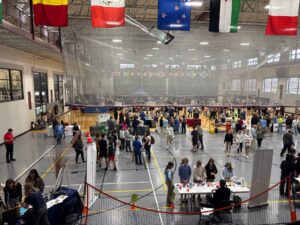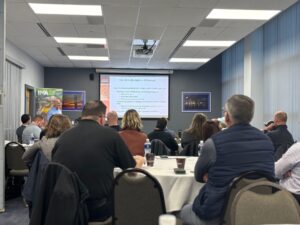
QUINCY — Makayla Beaston thinks she wants a career in the medical field.
But talking with professionals from a wide array of career fields at the Career Spark STEAM Expo “has given me more ideas of different things,” the St. Peter eighth-grader said. “It gives us more of an eye-opener for what we’ll do when we’re older outside the classroom.”
Nearly 400 eighth-grade students from 11 area schools took part in Wednesday’s expo highlighting career paths available in science, technology, engineering, arts and math.
“We hope that students will have a better understanding of what is available around them as far as careers and a better idea of what they possibly want to do in the future,” said Taylor Rakers, district manager with Junior Achievement, which sponsored the expo with the Great River Economic Development Foundation and the Learning Technology Center.
The students, who potentially could be in the workforce before 2030, heard from representatives of 39 businesses divided into three career clusters in Quincy University’s Health and Fitness Center.
“It gives me a better opportunity to learn about some new stuff,” Payson eighth-grader Juston Casey said.
Mendon eighth-grader Addalyn Landwehr, who wants to be an ultrasound technician, focused on the health care professionals.
“It gives me a perspective on learning what I want to do for my job when I’m older,” she said.
Junior Achievement has offered career fairs since 2016, Rakers said, but Career Spark provided something different to students.
“The old ones were lecture-style format in a classroom setting. Business professionals would come in and tell about their careers,” he said. “With this format, they’re going to show the kids what they do for their career. We’re encouraging hands-on exhibits and activities so students can see, touch and feel versus being told.”
Blessed Sacrament eighth-grade Allison Lenane tried her hand at painting with a virtual reality system displayed by Knapheide.
While that may not be her career choice, “it was a good try to see what it would kind of be like,” said Allison, who leans toward working in hair or cosmetology.
The expo, she said, was equally good for students.
“It’s going to be good so I can see other opportunities I have to see if I’m interested in anything else,” she said.
“Anytime we get to get in front of kids and show them what’s out there and what’s possible, I think it’s really important,” said Travis Brown, chief business development officer with the Relish Jar, who talked with students.
SIU Center for Family Medicine residents encouraged students to test out a stethoscope and to take a look inside their ears.
“In the rural areas, there’s a big need for primary care doctors especially throughout West-Central and Southern Illinois. We are really working on trying to recruit kids early to understand the process of becoming a doctor,” said Dr. Owen Alford-Bichsel, a first-year resident born and raised in Quincy.
“The commitment to being a doctor is pretty big. Knowing that early on can help a lot of students. Maybe they’re the first in their family to become a doctor and don’t know how much schooling is involved, how much debt is involved. We’re kind of providing that information.”
Hamilton science teacher Haleigh Hempen-Bell hopes her students find something that interests them at the expo.
“With our junior high kids, I’m not expecting for them to have their life planned out, but it would be helpful for them to know an area they would like to go into so they can help narrow their direction down in high school,” Hempen-Bell said.
The expo aims to bridge the gap between education and employment by demonstrating how STEAM-related fields play a vital role in everyday life and the workforce.
“Career Spark is about sparking curiosity and helping students connect their classroom learning to real-world opportunities,” GREDF Director of Workforce and Community Development Cole Schwartz said.




